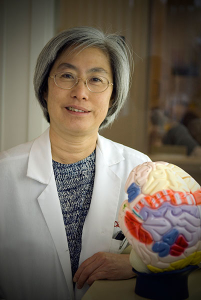Keck School researchers are advancing the understanding of Alzheimer’s disease and pursuing potential therapies

Terrence Town, PhD
Twenty years ago, when Terrence Town, PhD, first began researching the connection between Alzheimer’s disease and the immune system, most people in the field thought this course of inquiry was leading nowhere. Alzheimer’s disease was still poorly understood and so, while Town thought this was worthy of exploration, there was little evidence to back him up. Town was essentially betting his academic career on a hunch.
“I absolutely could have been barking up the wrong tree,” says Town, professor of physiology and biophysics at the Keck School of Medicine of USC.
Town points this out to illustrate just how far research on Alzheimer’s disease has come in the last couple of decades. While theories about the immune system were readily dismissed when he started researching this in the 1990s, inflammation has since been identified as a key player in Alzheimer’s disease, which is characterized by a build-up of plaque in the brain, made from a protein called beta-amyloid.
Fueled by a growing awareness about Alzheimer’s as well as new medical technology, research has yielded discoveries about the disease at a rapid clip. Scientists have uncovered the biological processes involved, identified genes and lifestyle factors that put people at risk, revealed the way in which the disease progresses and discovered that the pathology of the disease begins long before symptoms appear.
What has eluded scientists so far is an effective treatment for Alzheimer’s. The researchers at the Keck School believe a breakthrough is near and are pushing forward to find that therapy that is going to finally change the course of care for the millions of Americans who suffer from Alzheimer’s disease.
“Alzheimer’s disease is the public health crisis of our time, and effective treatment does not yet exist,” says Town, adding that much of the research, including his, is working to find new targets for effective treatments for Alzheimer’s disease.
Today, 5.3 million Americans have Alzheimer’s disease — the most common form of dementia that is irreversible and causes problems with memory, thinking and behavior. According to the Alzheimer’s Association, that figure is expected to grow to 13.8 million by 2050, costing $1.1 trillion per year, mostly to Medicare and Medicaid.
Studying the Brain
Those figures speak to the urgency of Alzheimer’s disease research, says Lon Schneider, MD, professor of psychiatry, neurology and gerontology at the Keck School of Medicine, and why the Keck School has so many initiatives devoted to better understanding of the disease.

Lon Schneider, MD
Schneider directs the USC State of California Alzheimer’s Disease Research Center and the clinical core of the USC National Institute on Aging Alzheimer’s Disease Research Center. He adds that Keck School scientists and physicians participate in two federally funded programs — the Alzheimer’s Disease Cooperative Study and the Alzheimer’s Disease Neuroimaging Initiative. The Keck School participates in the Alzheimer’s Disease Genetics Consortium, a research project funded by the National Institutes on Aging.
Most recently, the Keck School was asked to join the Brain Health Registry, connecting with UC San Francisco to recruit people for an online neuroscience study. From their home computers, individuals will take online brain tests — the goal of which is to create a massive pool of potential participants in clinical trials for the future.
In addition to collaborating with research groups across the country, the researchers at the Keck School also pursue individual research projects aimed at finding treatments that will benefit the millions of Americans and their families who are struggling with Alzheimer’s. Town’s research, for example, has not only proven to be enlightening on the interplay between the immune system and Alzheimer’s, but has also identified important targets for future therapies.
For more than 15 years, he has researched various types of immune responses in the brain, blocking some and activating others, to understand which play key roles in the development of Alzheimer’s disease. Most recently, he and his team showed that blocking an immune suppressor called interleukin-10 activates a beneficial immune response that appears to clear the brain of the toxic plaque buildup that is the hallmark of Alzheimer’s disease. In mice with Alzheimer’s, blocking interleukin-10 appeared to restore learning and memory and to block injury to brain cells. In doing so, Town discovered a promising avenue for treating this disease.
Town’s lab is part of the Keck School’s Zilkha Neurogenetic Institute (ZNI), led by Berislav Zlokovic, MD, PhD, another pioneer in Alzheimer’s disease research whose research has illuminated the role that blood vessels in the brain play in the development of dementia.
Understanding the Brain

Berislav Zlokovic, MD, PhD
Zlokovic, professor and chair of the Department of Physiology and Biophysics at the Keck School, first proposed, more than 20 years ago, that flaws in the blood-brain barrier, which keeps potentially dangerous foreign substances from moving from blood vessels into brain tissue, underlie all cognitive disorders, including Alzheimer’s disease. At the time, most Alzheimer’s researchers were focused on the plaques in the brain, which are the hallmark of Alzheimer’s disease.
For decades, Zlokovic and his research team have made significant advances in understanding the blood-brain barrier and its role in Alzheimer’s. Several of his discoveries have already contributed to the development of clinical trials for Alzheimer’s disease, yet he continues to make new discoveries.
In 2015 alone, he and his team of researchers at ZNI have published new findings in three major journals. They were able to show — using high-resolution imaging of the living human brain — that the blood-brain barrier becomes leaky with age. They also showed that deficiencies of a protein called GLUT1, which helps move glucose across the blood-brain barrier, lead to vascular injuries that exacerbate the effects of Alzheimer’s disease. Zlokovic also discovered that a deficiency of a protein known as PICALM in cerebral blood vessels is associated with a diminished capacity to clear amyloid-beta from the brain.
With Zlokovic as a pioneer in the field, there is now significant evidence that vascular dysfunction is an early event in Alzheimer’s disease. Zlokovic’s latest round of discoveries has unveiled many potential targets for novel treatments and he continues to investigate treatment efforts of his earlier studies. For example, he previously discovered that damage of brain microvascular cells, called pericytes, leads to reduced blood flow and exposure of toxins to the brain. Zlokovic is hopeful that he will find a way to target pericytes at the blood-brain barrier in a way that will help patients suffering from dementia.
Meanwhile, he has also embarked on the hunt for biomarkers in blood and cerebrospinal fluid that he hopes can predict the onset of Alzheimer’s disease 10 to 15 years before the onset of symptoms. This would be a huge advance in the field, since Alzheimer’s diagnosis is currently triggered with the onset of symptoms. Zlokovic added that the pace of discovery has been aided by an explosion of medical technology that has helped researchers better understand Alzheimer’s.
“Advanced technology — imaging and genetics — are very important in Alzheimer’s research,” says Zlokovic. “There are currently gaps in knowledge, but technology is helping us address important questions and is getting us there faster.”
Picturing the Brain

Paul Thompson, PhD
Powerful, new technology in the field of brain imaging is also helping to advance understanding of Alzheimer’s disease by finally giving researchers the ability to track changes in the living brain. Paul Thompson, PhD, professor of neurology, psychiatry, radiology, engineering and ophthalmology at the Keck School, joined the school in 2013 and brought with him 20 years of brain mapping experience.
Thompson’s research first revealed, about 15 years ago, the manner in which Alzheimer’s progresses. “It is an odd disease because it sweeps through the brain like a forest fire,” says Thompson, adding that imaging showed it first attacks the memory center, then leap-frogs to the emotions centers and later hits the frontal lobes, which are involved in planning and self-control.
Thompson leads the ENIGMA (Enhancing Neuro Imaging Genetics through Meta-Analysis) network, the world’s largest brain-mapping project — a collaboration of 190 global institutions. Combining forces and sharing brain scans, along with information on patients’ health and genetic profiles, has helped Thompson identify genetic risk factors for Alzheimer’s. Recently, utilizing information from the ENIGMA group, Thompson was able to show that a common variant in the gene TREM2 speeds brain cell loss in elderly people and in those with Alzheimer’s disease.
Imaging techniques have also made it simpler and less-costly, notes Thompson, for researchers doing clinical trials, to evaluate the efficacy of a treatment. “It can make drug trials much less expensive and we won’t have to wait three to five years to figure out if something is effective,” says Thompson.
Treating the Brain
In the case of Alzheimer’s disease, Schneider adds that the research taking place at Keck Medicine helped the doctors at Keck Medicine give patients the best possible care. The physicians have access to the latest information, as well as cutting edge technology, to help patients as best they can.

Helena Chang Chui, MD
Several clinical trials are underway, three of which are led by Schneider, through the Alzheimer’s Disease Research Center, to test investigational drugs. Some of the drugs being tested are aimed at improving the cognitive function of patients with mild or moderate Alzheimer’s disease or slow the progression of the disease. One trial tests a type of immunotherapy in patients at high risk of developing Alzheimer’s, but before the onset of symptoms; and another early phase trial assess a neuroregenerative compound. The Alzheimer’s Disease Research Center is also participating in a neuroimaging study funded by the National Institutes of Health that will take brain images, as well as biomarker measures, to track changes in the living brain over time.
“We are committed to giving our patients the highest quality of care,” says Helena Chui, MD, McCarron Professor of Neurology at the Keck School and chair of the Department of Neurology. “Our practice benefits by having access to top researchers in the field who finding ways to better diagnose and treat Alzheimer’s disease.”
Patients and their families are understandably impatient, notes Schneider, adding that while progress seems slow, research has progressed tremendously in the time since he and his colleagues first started to study the disease. And that fact, he says, should give everyone hope.
“I think there is a lot to be hopeful about,” says Schneider, “and I believe there is going to be a breakthrough on the treatment front.”
By Hope Hamashige